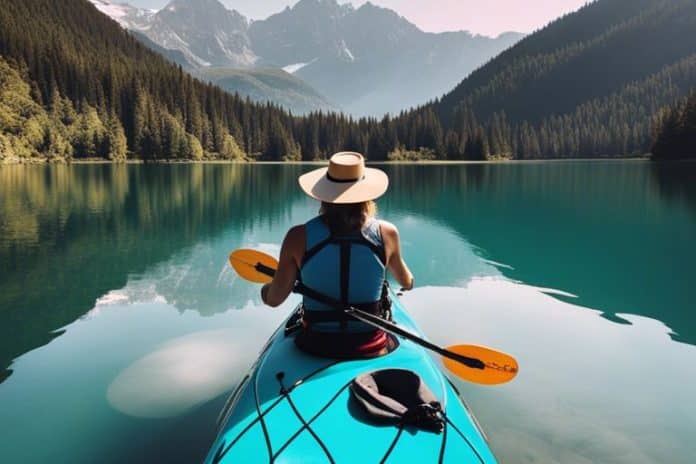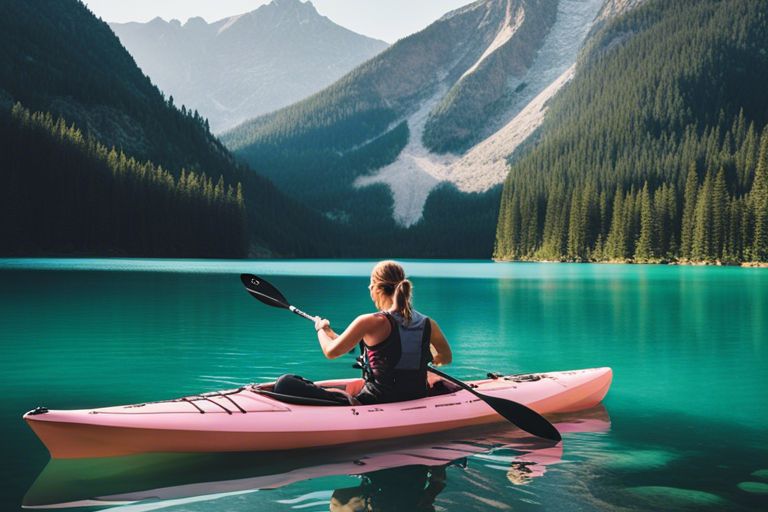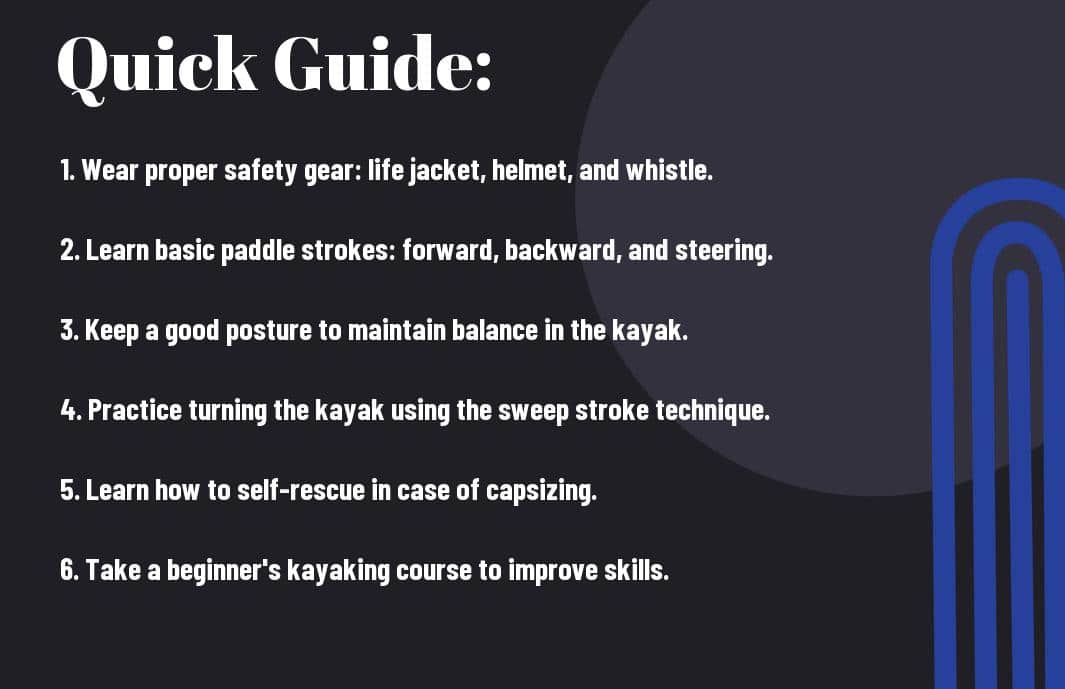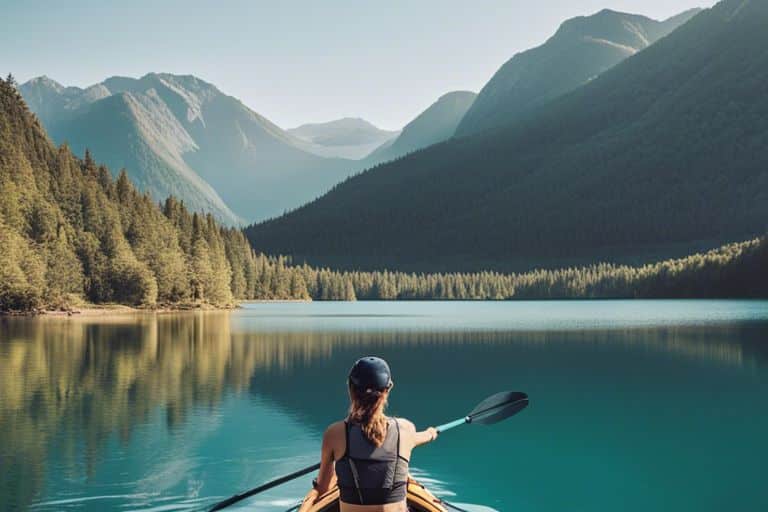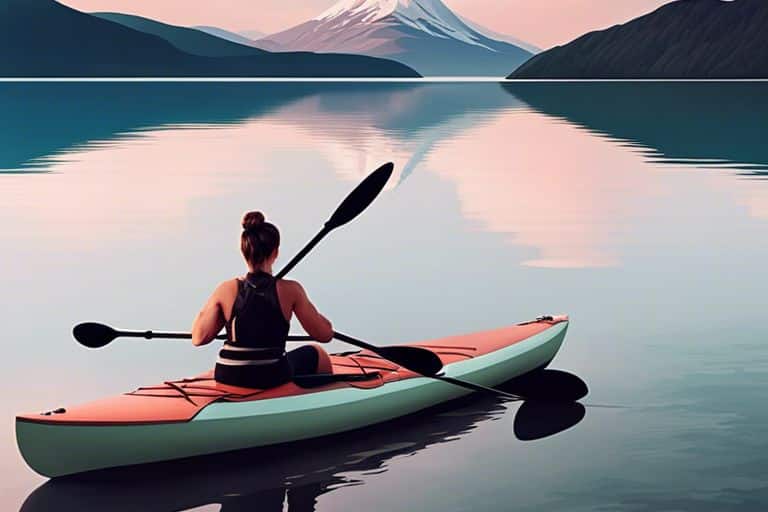Kayaking is an exhilarating water sport that offers a fantastic way to explore nature and stay active. Mastering basic kayaking techniques is crucial to having a safe and enjoyable time on the water. In this guide, we will cover crucial skills such as paddling, maneuvering in different water conditions, and rescuing yourself in case of emergencies. Understanding these fundamental techniques will not only increase your confidence but also enhance your overall kayaking experience. Whether you are a complete novice or looking to brush up on your skills, this guide will provide you with the knowledge you need to start your kayaking journey smoothly.
Key Takeaways:
- Proper paddling technique: Ensure your hands are shoulder-width apart, rotate your torso to paddle efficiently, and keep your arms straight to avoid strain.
- Mastering the art of steering: Use short, quick strokes for sharp turns and longer strokes for gradual turns. Practice different types of strokes to navigate effectively.
- Bracing techniques: Learn how to brace with your paddle to stabilize your kayak and prevent tipping over in rough water or strong currents.
- Understanding edging: Tilting your kayak on its edge can improve your maneuverability and stability, especially in choppy waters. Practice edging to enhance your kayaking skills.
- Launching and landing: Approach the water at a gradual angle to launch smoothly and use proper technique to land safely on the shore. Be mindful of any obstacles or currents.
- Safety tips: Always wear a personal flotation device (PFD), dress for the water temperature, stay hydrated, and be aware of your surroundings. Familiarize yourself with rescue techniques in case of emergencies.
- Practice makes perfect: The more you practice kayaking techniques, the more confident and skilled you will become. Take lessons, join group paddles, and continue learning to enhance your kayaking experience.
Essential Kayaking Techniques
The Basic Paddle Stroke
Now, let’s research into the fundamental kayaking technique – the basic paddle stroke. Assuming you are holding the paddle correctly with hands shoulder-width apart, dip the blade fully into the water near your feet. Pull the blade towards your hip while rotating your torso for maximum power. Finish the stroke by lifting the paddle out of the water near your hip and repeat on the other side.
Turning Techniques
Clearly, mastering turning techniques is important for navigating different environments while kayaking. To initiate a turn, use a sweep stroke by extending the paddle blade away from the kayak and sweeping it in a wide arc towards the stern. This will help you turn efficiently without losing momentum.
Turning techniques are crucial for maneuvering swiftly through obstacles and changing currents. By practicing different strokes like the sweep and draw, you can enhance your agility on the water and enjoy a safer kayaking experience.
Bracing to Prevent Capsizing
Turning to bracing techniques, it’s vital to learn how to prevent capsizing in challenging conditions. To brace effectively, keep your upper body relaxed and use the paddle as a supportive outrigger when feeling unstable. This technique will help you stay balanced and avoid tipping over in rough waters.
To prevent capsizing, maintaining a strong core and quick reflexes is key. By practicing bracing techniques regularly in controlled environments, you can build the confidence to handle unexpected situations with ease.
The Eskimo Roll for Recovery
On the topic of recovery, understanding the Eskimo roll is crucial for kayakers looking to navigate whitewater or turbulent conditions. To execute the Eskimo roll, tuck your body forward and use a hip snap to right your kayak while keeping the paddle close to the water surface. This technique can help you recover from a capsized position quickly and efficiently.
Mastering the Eskimo roll can be a game-changer for kayakers tackling challenging waters. With regular practice and proper technique, you can enhance your safety on the water and confidently navigate through unpredictable conditions.
Types of Kayaking
To provide a comprehensive overview of kayaking techniques, it is vital to understand the various types of kayaking. The main keywords to differentiate kayaking styles are recreational kayaking, sea kayaking, whitewater kayaking, and kayak fishing. Each type offers a unique experience and requires specific skills and equipment. Knowing the differences can help beginners choose the right style that suits their interests and abilities. Thou, let’s probe into each type to gain a better understanding.
| Recreational Kayaking | Sea Kayaking |
| Whitewater Kayaking | Kayak Fishing |
Recreational Kayaking
With recreational kayaking, individuals can enjoy calm waters such as lakes, ponds, or slow-moving rivers. It is a leisurely activity suitable for beginners who want to explore nature safely and peacefully. Recreational kayaks are stable and easy to maneuver, making them ideal for casual paddlers looking for relaxation on the water.
Sea Kayaking
Types of sea kayaking involve navigating through open waters such as oceans, bays, or seas. Sea kayaks are longer and narrower, designed for greater speed and stability in rough conditions. Understanding tides, currents, and marine life is crucial for safety and a more enjoyable experience. Sea kayaking offers opportunities for long-distance journeys and exploring remote coastlines.
Whitewater Kayaking
Little adventures and adrenaline seekers are drawn to whitewater kayaking, which involves paddling through fast-moving rivers and rapids. This exciting and challenging sport requires technical skills, agility, and quick decision-making. Protective gear such as helmets and drysuits are crucial for safety in turbulent waters.
Kayak Fishing
Kayaking for fishing adds a new dimension to the sport, allowing enthusiasts to access remote fishing spots not reachable by land. The quiet and stealthy nature of kayaks enables anglers to get closer to fish without disturbing them. Kayak fishing requires specialized equipment such as fishing rod holders and storage for gear, enhancing the overall fishing experience.
Factors Affecting Your Kayaking Experience
Not just anyone can hop into a kayak and start paddling without considering the various factors that can impact their experience on the water. From the type of kayak you choose to the weather conditions you encounter, several elements can make or break your time out on the water. Any experienced kayaker will tell you that being mindful of these factors is crucial for a safe and enjoyable adventure.
Choosing the Right Kayak
Right from the beginning, selecting the right kayak is necessary for a smooth paddling experience. Consider the type of water you’ll be navigating – calm lakes, whitewater rivers, or open oceans – and choose a kayak that suits the conditions you’ll be facing. Factors like stability, maneuverability, and weight should all be taken into account to ensure you have the best possible kayak for your adventure.
Weather and Water Conditions
Choosing the right time and place to go kayaking is crucial for a safe and enjoyable experience. Before heading out, check the weather forecast, wind conditions, and tides to ensure you’re prepared for what lies ahead. A calm, sunny day might be perfect for a leisurely paddle on a lake, while rough waters and strong winds could pose a challenge for even the most experienced kayaker.
Planning Your Route
With careful planning, you can make the most of your kayaking adventure. Take into account the distance you’ll be covering, any potential hazards along the way, and the time it will take to complete your route. Consider factors like currents, tides, and shoreline access to map out a safe and enjoyable journey.
Safety Considerations and Equipment
To ensure a safe kayaking experience, it’s crucial to prioritize kayaking safety considerations and have the right equipment on hand. This includes wearing a properly fitted life jacket, carrying necessary gear like a whistle and first aid kit, and knowing basic rescue techniques. Being prepared for emergencies and having the necessary skills and equipment can make all the difference in staying safe on the water.
Step-by-Step Guide to Your First Kayaking Trip
Many beginners feel a mix of excitement and nervousness before launching on their first kayaking trip. To help ease those feelings, it’s important to be well-prepared for the adventure ahead. Here is a breakdown of what to expect and how to navigate through your first kayaking experience.
| Preparing for Your Adventure | Launching Your Kayak |
Preparing for Your Adventure
On your first kayaking trip, be sure to pack vital items such as a life jacket, water shoes, sunscreen, snacks, and plenty of water. Familiarize yourself with the route you’ll be taking, check the weather forecast, and let someone know your itinerary. Safety should always be a top priority when preparing for your kayaking adventure.
Launching Your Kayak
Your first task when launching your kayak is to ensure that it is stable and positioned correctly in the water. Step into the kayak carefully, maintaining your balance. Push yourself off gently from the shore using your paddle to start moving. Remember to keep a firm grip on your paddle and stay focused as you begin your journey on the water.
Navigating on the Water
Understanding how to navigate on the water is crucial for a successful kayaking trip. Some key points to remember include keeping a straight posture, using proper paddling techniques, and being mindful of your surroundings. Pay attention to any obstacles or changes in the water currents to navigate safely.
Returning and Taking Out Your Kayak
Step-by-step, guide your kayak back to shore by following the reverse process of launching. Adventure and excitement aside, safety should always remain a top priority when returning and taking out your kayak. Be mindful of your surroundings and any changes in the water conditions as you approach the shore to ensure a smooth and secure landing.
A successful kayaking trip requires careful preparation, focused navigation, and a keen awareness of safety measures. By following these steps and staying informed, you can enjoy a thrilling and memorable experience on the water.
Tips and Tricks for Enhancing Your Paddling Technique
All beginners will benefit from improving their paddling technique to enhance their overall kayaking experience. Here are some tips and tricks to help you paddle more efficiently and effectively:
- Focus on proper grip and posture to avoid fatigue and prevent injuries
- Use your core muscles to generate power and maintain stability
- Practice different paddling strokes to navigate various water conditions
- Stay relaxed and fluid in your movements to conserve energy and improve speed
This will help you become a more confident and skilled kayaker, allowing you to explore new waters with ease.
Improving Strength and Endurance
Technique is vital when it comes to kayaking, but strength and endurance are equally important. To improve your overall performance on the water, focus on gradually increasing your strength-training routines and incorporating cardiovascular exercises like paddling longer distances or sprint intervals.
Advancing Your Strokes and Control
Strength lies in mastering advanced strokes and control techniques. By refining your forward stroke, sweep stroke, and draw stroke, you can maneuver your kayak more efficiently and with greater precision. Regular practice and proper form are key to mastering these techniques, allowing you to navigate through challenging waters with confidence.
Kayaking Etiquette and Environmental Awareness
The importance of understanding kayaking etiquette and being environmentally aware cannot be overstated. Always respect wildlife and marine ecosystems by keeping a safe distance and avoiding disturbing natural habitats. Additionally, be mindful of other kayakers and watercraft by yielding when necessary and following designated paddling routes. By practicing responsible kayaking behavior, you contribute to the preservation of our natural waterways and promote a safe and enjoyable paddling environment for everyone.
Pros and Cons of Kayaking
| Pros | Cons |
| Great exercise | Weather conditions can be unpredictable |
| Connects you with nature | Requires proper technique to avoid injuries |
| Relaxing and stress-reducing | Equipment and gear can be expensive |
| Can be done solo or with others | Time consuming to learn and master |
| Accessible to people of all ages | Requires transportation of kayak to water bodies |
Benefits of Paddling
Even though kayaking requires physical effort, the benefits of paddling are numerous. It improves cardiovascular health, strengthens core muscles, and enhances overall fitness levels. Additionally, spending time on the water can boost mental well-being, reduce stress, and provide a sense of tranquility and relaxation.
Common Challenges and How to Overcome Them
On the other hand, kayaking comes with its own set of challenges. It’s common for beginners to struggle with balance and coordination, especially in rough waters. It is imperative to start with calm waters, practice basic strokes, and gradually build up your skills. Investing in a lesson with a professional instructor can also help you overcome any initial difficulties and boost your confidence on the water.
Final Words
So, now that you’ve learned the basics of kayaking techniques from this beginner’s guide, you’re ready to hit the water with confidence. Remember to practice your paddle strokes, master your turns, and always prioritize safety while out on the water. With time and experience, you’ll become a skilled kayaker capable of navigating various water conditions. Keep exploring new techniques, stay curious, and most importantly, have fun paddling!
FAQ
Q: What is the importance of learning kayaking techniques as a beginner?
A: Learning kayaking techniques as a beginner is crucial for your safety on the water. Understanding proper paddling techniques, balance, and rescue methods will enhance your overall kayaking experience and help prevent accidents.
Q: What are some imperative kayaking techniques for beginners to master?
A: As a beginner, you should focus on mastering basic paddling techniques such as forward stroke, reverse stroke, sweep stroke, and draw stroke. Learning how to control your kayak effectively will make your paddling more efficient and enjoyable.
Q: How can beginners improve their kayaking skills and technique?
A: Beginners can improve their kayaking skills by taking lessons from a certified instructor, practicing regularly in different water conditions, and gradually challenging themselves with more advanced techniques. Building a strong foundation and gaining experience will help you become a proficient kayaker.
